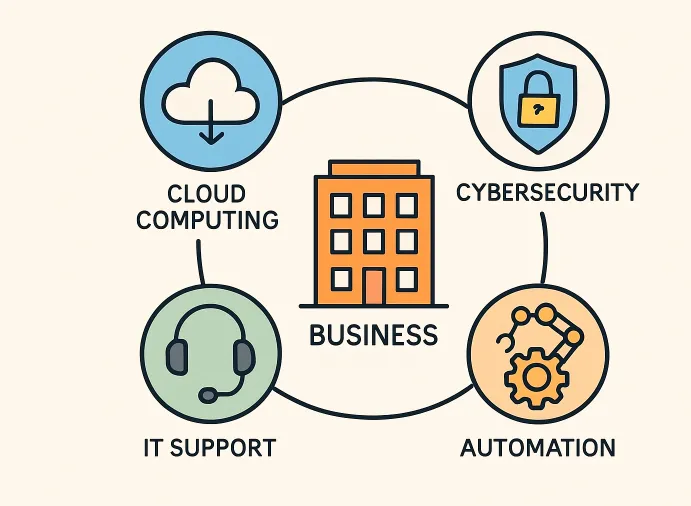Comprehensive Guide to Modern Business IT Solutions
In today’s rapidly evolving digital landscape, businesses must integrate the right technology to remain competitive, secure, and innovative. As organizations face increasing pressure from cyber threats and the demand for seamless operations, having access to a knowledgeable professional IT services provider is more important than ever. Robust IT strategies can propel your business forward—whether it’s enhancing productivity, guarding sensitive data, or enabling remote workforces.
Staying ahead means ensuring your IT infrastructure scales with growth, adapts to new technologies, and withstands emerging risks. Modern IT solutions deliver not just operational efficiency but the peace of mind needed to focus on core business activities. Understanding, implementing, and optimizing these solutions are fundamental steps for any business seeking success in the digital age.
Also Read: Acumatica HubSpot Integration: Flawless 2-Way ERP–CRM Data Sync
This guide explores the key facets of innovative IT systems, enabling organizations to leverage technology for sustainable growth and digital transformation. By examining essential areas such as cybersecurity, cloud computing, automation, and the process of selecting a strategic IT partner, you’ll gain actionable insights critical to your company’s future.
Understanding Modern IT Solutions
Modern IT solutions are a sophisticated blend of technologies and services designed to enable better business results. These solutions encompass Managed IT Services, along with cutting-edge cybersecurity, cloud, and analytics tools, all streamlined to deliver efficiency, scalability, and resilience across an organization. By leveraging these systems, organizations can quickly adapt to market shifts, reduce costs, and foster innovation.
Strategic deployment of IT resources also enables teams to focus on core business drivers rather than troubleshooting technical issues. For many, digital transformation has opened new paths to customer engagement, internal collaboration, and decision-making, thanks largely to the seamless integration of advanced IT solutions.
Key Components of Effective IT Strategies
A solid IT strategy serves as a blueprint for both immediate needs and long-term growth. The effectiveness of any IT approach is built around a handful of foundational components:
- Infrastructure Modernization: Updating legacy hardware and outdated software ensures compatibility, performance, and better security.
- Managed IT Services: Outsourcing functions such as network management, technical support, and security enables expert oversight and ongoing optimization.
- Data Security: Comprehensive data protection through encryption, threat detection, and robust backup strategies is critical to safeguarding sensitive business and customer information.
- Cloud Integration: Migrating operations and applications to the cloud provides the flexibility and scalability necessary to thrive in a rapidly changing environment.
Organizations that blend these elements can better mitigate risks and create a technology environment that drives efficiencies.
Cybersecurity Measures for Businesses
Protecting digital assets is non-negotiable in today’s threat landscape. Businesses need to implement robust security protocols to defend against malware, phishing, ransomware, and insider threats. Key cybersecurity measures include:
- Firewalls and Antivirus Software: These serve as the first line of defense, blocking unauthorized access and malicious software.
- Multi-Factor Authentication (MFA): Requiring additional verification drastically reduces the risk of unauthorized logins and protects valuable data.
- Regular Security Audits: Proactive audits and penetration testing identify vulnerabilities before they can be exploited, ensuring your security posture evolves in tandem with new threats.
Keeping up with cybersecurity best practices and employee training—such as frequent awareness programs—can drastically reduce the chance of a successful attack.
Also Read: How to Update Winobit3.4 Python: A Complete Guide
Cloud Computing and Data Management
Cloud computing revolutionizes how organizations manage operations, data storage, and collaboration. By leveraging these services, businesses can achieve:
- Scalability: Resources can be adjusted on demand to meet shifting business needs, ensuring you never overpay or underperform.
- Remote Accessibility: Employees can securely access information and tools from anywhere, which is increasingly valuable for distributed teams.
- Data Backup: Regular cloud backups ensure critical data is both secure and recoverable in the event of disaster, outage, or cyberattack. According to TechTarget, following well-defined backup best practices such as maintaining multiple copies of data, performing regular recovery tests, and keeping off-site backups helps organizations strengthen their overall resilience. These strategies not only safeguard sensitive information but also ensure business continuity in the face of unexpected disruptions.
Optimal data management through cloud platforms helps businesses lower costs, improve compliance, and streamline workflows—all of which are necessary for robust business continuity strategies.
Leveraging AI and Automation
Artificial Intelligence (AI) and automation aren’t just buzzwords—they’re transformative technologies that help organizations operate smarter and faster. Notable business applications include:
- Process Automation: Routine, repetitive tasks are automated, reducing errors and freeing up time for high-value work.
- Data Analysis: Advanced analytics extract actionable insights from vast datasets, helping leaders make informed decisions quickly.
- Customer Service: AI-powered chatbots and virtual assistants provide instant, 24/7 support, improving customer satisfaction and reducing response times.
Businesses integrating AI-driven solutions are seeing substantial improvements in efficiency and customer experience, underscoring the growing importance of these technologies.
Choosing the Right IT Partner
Selecting the best IT service provider is a strategic decision that directly impacts your organization’s ongoing security, productivity, and innovation. Considerations when evaluating potential partners include:
- Experience: Look for a provider with a demonstrated track record within your industry and with businesses of similar size and complexity.
- Comprehensive Services: The ideal partner offers a wide range of tailored solutions, from consulting and implementation to proactive monitoring and emergency response.
- Support Availability: Around-the-clock support ensures rapid issue resolution, minimizing downtime and disruption to business operations.
Building a relationship with the right IT partner sets the stage for seamless technology integration and responsive, expert support whenever you need it.
Future Trends in Business IT
Remaining competitive means keeping an eye on the horizon. Several influential trends are shaping the future of business IT:
- AI Integration: More advanced, context-aware AI will inform real-time decisions and unlock greater levels of productivity and innovation.
- Internet of Things (IoT): Connected devices are enabling businesses to collect more detailed operational data, supporting automation and predictive maintenance.
- Zero Trust Security Models: Rather than trusting users by default, Zero Trust models require strict verification for every access request, significantly improving data protection.
These advancements will continue to redefine IT’s impact on business, empowering leaders to stay agile, informed, and resilient.
Conclusion
Modern IT solutions are essential for any business intent on thriving in a digital-first world. By understanding and adopting forward-thinking strategies—ranging from cybersecurity and cloud computing to implementing AI and choosing the right IT partners—businesses can position themselves not just for protection but for bold innovation and sustainable growth.







